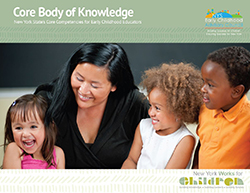
Core Body of Knowledge
New York State's Core Competencies for Early Childhood Educators

7.2
Resources for Competency 7.2:
click to view resource list
Adheres to NYS and Local Regulations
The professional working with young children maintains systems that adhere to all New York State and local regulatory requirements, as well as best practices related to health, safety and nutrition
Resources & Media for Understanding Competency 7.2
Behaviors & Skills
-
aHas written policies and procedures that outline what health and safety information is to be collected from each family, and ensures that it is updated at least quarterly
-
bMaintains files with health and safety information for each family in a central location within the program
-
cExplains confidentiality requirements regarding health and safety information to staff
-
dEnsures that children have received routine screenings and immunizations according to the recommended schedules issued by the American Academy of Pediatrics, the Centers for Disease Control, and the Academy of Family Practice
-
eFollows relevant regulations pertaining to the administration of medicine to children and special medical procedures needed by enrolled children
-
fMaintains plans that have been approved by a health official regarding inclusion of staff or children that are ill (i.e., what types of illnesses require exclusion)
-
gProvides space, supervision and comfort for ill children waiting to be picked up from the program
-
hProvides information verbally and in writing to families about any communicable disease to which their child might have been exposed. Information should include: signs and symptoms of the disease, mode of transmission, period of communicability, and control measures that are being implemented at the program and that families should implement at home
-
iMaintains procedures to reduce occupational hazards (i.e., back strain, falls) and exposure to infectious diseases
-
jProvides staff with resources and referrals to support their well-being (i.e., stress-management, treatment for depression, wellness, etc.)
-
kHas written policies that require children have outdoor gross motor play each day. When children cannot play outside, makes sure that staff arrange for indoor gross motor activities
-
lArranges for the use of assistive technology to improve services for children with special needs
-
mMaintains written procedures that address all aspects of arrival, departure, and transportation of children
-
nProvides for adequate supervision and monitoring of children throughout the day
-
oHas written policies and procedures for reporting child abuse and neglect that comply with federal, state, and local laws
-
pHas written policies and procedures to be followed if a staff member is accused of abuse or neglect of a child in the program that protect both the rights of the accused staff person and the children in the program
-
qMakes sure that staff can provide proof of current training in required health and safety topics. These topics may include but are not limited to: CPR training, prevention and reporting of child abuse and maltreatment, preventing infectious diseases, etc.
-
rMaintains written, current, thorough procedures consistent with applicable regulatory agency requirements, for preparing for and handling major medical emergencies for children and adult staff
-
sHas written policies and procedures to protect children and adults from environmental hazards (i.e., asbestos, lead, air pollution, etc.) in accordance with requirements outlined by applicable regulatory agencies
-
tMaintains written and posted disaster preparedness and emergency evacuation procedures
-
uMakes sure that staff prepare, serve, and store food in line with U.S. Department of Agriculture Child and Adult Food Care Program (CACFP) guidelines, as well as the requirements outlined by applicable regulatory agencies
-
vEnsures that a registered dietitian or pediatric public health nutritionist evaluates the menus for nutritional content at least two times a year, unless the program participates in the U.S. Department of Agriculture’s CACFPFood Program (CACFP)
-
wPosts menus and provides copies to families
-
xEnsures that drinking water is clean and sanitary
